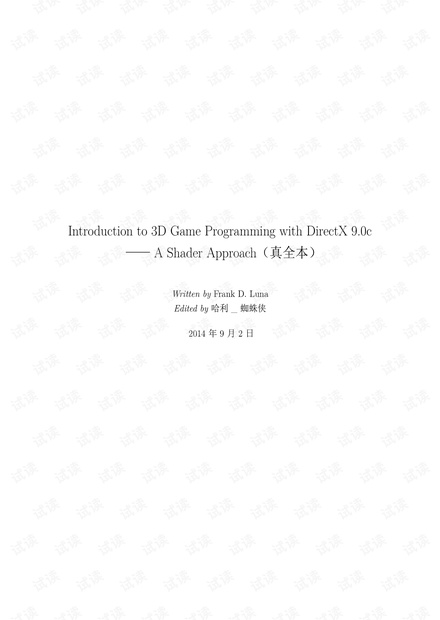没有合适的资源?快使用搜索试试~ 我知道了~
首页龙书 Introduction to 3D Game Programming with DirectX 9 0c 着色器版彩图注释修正版1.3
这是Frank D. Luna的“龙书”的第二版(原名《Introduction to 3D Game Programming with DirectX 9.0c——A Shader Approach》)的彩图注释修正版。当然这个修正是非官方的。网上能够找到的“龙书”第二版基本都是用来自于同一个chm文件,或者是该chm文件转成的pdf版本。这个版本有很多错误,而且图片大多不清晰。而本人便将这个电子版的错误进行了修正。综合来说,本电子版有以下几个特点: 1、将各种“打印错误”或者原有的错误进行了修正。当然修改得好不好还要靠大家评判了。 2、将原书的插图进行了重新的绘制或者截取,是高清彩色的。注意:如果觉得图片显示不清晰或者有锯齿的话,那么增大显示比例一般就没问题了。 3、对一些讲得不太清楚的地方用脚注的形式进行了补充。 4、对一些过时的内容通过脚注的形式进行了更新。 5、对一些问题通过脚注的形式进行了提示。 6、对每一页的布局进行了调整,字数比较多,但是没有原始电子版那么多。 当然,目前这个电子版尚未完成,现在给你们的是前11章的。如果反响好的话,我会考虑把整个电子版弄出来然后发给大家的。有一些地方有红色的“有问题”字样,是尚未完成、有待后来补充的内容,大家请忽略。
资源详情
资源评论
资源推荐

Introduction to 3D Game Programming with DirectX 9.0c
—— A Shader Approach(真全本)
Written by Frank D. Luna
Edited by 哈利 _ 蜘蛛侠
2014 年 9 月 2 日

编者的话
本电子书是 Frank D. Luna 的“龙书”的第二版(原名 Introduction to 3D Game Programming with
DirectX 9.0c —— A Shader Approach)的修正版。当然这个修正是非官方的。网上能够找到的“龙书”第二
版基本都是用来自于同一个 chm 文件,或者是该 chm 文件转成的 pdf 版本。这个版本有很多错误,而且图
片大多不清晰。而本人便将这个电子版的错误进行了修正。综合来说,本电子版有以下几个特点:
1. 对每一页的布局进行了调整,字数比较多,但是没有原始电子版那么多。
2. 将各种“打印错误”或者原有的错误进行了修正。当然修改得好不好还要靠大家评判了。
3. 将原书的插图进行了重新的绘制或者截取,是高清彩色的。注意:如果觉得图片显示不清晰或者有锯齿
的话,那么增大显示比例一般就没问题了。
4. 对一些讲得不太清楚的地方用脚注的形式进行了补充。
5. 对一些过时的内容通过脚注的形式进行了更新。
6. 对一些问题通过脚注的形式进行了提示。
希望大家学习愉快!
注意 本书未讲的、但是对于游戏编程不可或缺的知识点:
1. Windows 编程的基础知识(参见附录);
2. 详细介绍 DirectX 编程中的 2D 部分;
3. 如何制作一个游戏主菜单(包括开始游戏、选项、致谢表、退出游戏等功能);
4. 如何利用已有的脚本系统或者自己建立脚本系统来方便游戏的开发;
5. 如何载入过场动画;
6. 如何在游戏过程中显示人物状态界面(生命值、魔法值、怒气值等);
7. 如何设置无 UI 截图功能并且可以自动命名保存;
8. 如何做出一个技能表;
9. 如何实现手动存档、自动存档、读取存档的功能;
10. 如何在游戏场景中显示一个小屏幕(类似于电子监控画面);
11. 如何实现多线程编程;
12. 最后,如何将各方面知识综合起来,做出一款值得一玩的(小)游戏。
另外还有一些 3D 游戏中比较有用、但是并非必需的知识:
i

ii
1. 如何判断盾反;
2. 如何进行切换到慢镜头;
3. 如何实现角色模型的自定义创建(俗称“捏脸”)。

Introduction
Overview
This book presents an introduction to programming interactive computer graphics, with an emphasis on
game development, using real-time shaders with DirectX 9.0c. It teaches the fundamentals of Direct3D and
shader programming, after which the reader will be prepared to go on and learn more advanced techniques.
The book is divided into three main parts. Part I explains the mathematical tools that will be used throughout
this book. Part II shows how to implement elementary 3D techniques, such as defining 3D geometry, lighting,
texturing, alpha blending, and stenciling, using shaders and the HLSL. Part III is largely about applying
Direct3D to implement a variety of interesting techniques and special effects, such as working with meshes,
character animation, terrain rendering, picking, particle systems, environment mapping, normal mapping,
and rendering to textures.
For the beginner, this book is best read front to back. The chapters have been organized so that the
difficulty increases progressively with each chapter. In this way, there are no sudden jumps in complexity that
leave the reader lost. In general, for a particular chapter, we will use the techniques and concepts previously
developed. Therefore, it is important that you have mastered the material of a chapter before continuing.
Readers who are experienced Direct3D users can pick the chapters of interest.
Finally, you may be wondering what kinds of games you can develop after reading this book. The answer
to that question is best obtained by skimming through the book and seeing the types of applications that are
developed. From that you should be able to visualize the types of games that can be developed based on the
techniques taught in this book and some of your own ingenuity.
iii

iv
Changes from an Earlier Version
This update to the author’s Introduction to 3D Game Programming with DirectX 9.0 has been rewritten
almost from scratch. This book largely abandons the fixed pipeline used in the earlier version to give a
complete programmable, or shader, approach. From Chapter 8 onward, we are transforming, lighting, and
coloring vertices and pixels in vertex and pixel shaders. This significant revision in approach reflects the fact
that the fixed pipeline will not exist in DirectX 10.
Another key feature is the inclusion of end of chapter exercises. The exercises serve three purposes: first,
to test the reader’s understanding of each chapter’s contents; second, to provide the reader with Direct3D
programming experience; and third, to extend the chapter’s topics by asking the reader to investigate new
ideas on his or her own. In many cases, the exercises are not of the “plug and chug” type, but require the
reader to determine how to apply the chapter’s topics to the particular assignment. Readers are encouraged
to complete chapter exercises before moving on to the next chapter.
剩余340页未读,继续阅读
哈利_蜘蛛侠
- 粉丝: 93
- 资源: 78
上传资源 快速赚钱
 我的内容管理
收起
我的内容管理
收起
 我的资源
快来上传第一个资源
我的资源
快来上传第一个资源
 我的收益 登录查看自己的收益
我的收益 登录查看自己的收益 我的积分
登录查看自己的积分
我的积分
登录查看自己的积分
 我的C币
登录后查看C币余额
我的C币
登录后查看C币余额
 我的收藏
我的收藏  我的下载
我的下载  下载帮助
下载帮助

会员权益专享
最新资源
- RTL8188FU-Linux-v5.7.4.2-36687.20200602.tar(20765).gz
- c++校园超市商品信息管理系统课程设计说明书(含源代码) (2).pdf
- 建筑供配电系统相关课件.pptx
- 企业管理规章制度及管理模式.doc
- vb打开摄像头.doc
- 云计算-可信计算中认证协议改进方案.pdf
- [详细完整版]单片机编程4.ppt
- c语言常用算法.pdf
- c++经典程序代码大全.pdf
- 单片机数字时钟资料.doc
- 11项目管理前沿1.0.pptx
- 基于ssm的“魅力”繁峙宣传网站的设计与实现论文.doc
- 智慧交通综合解决方案.pptx
- 建筑防潮设计-PowerPointPresentati.pptx
- SPC统计过程控制程序.pptx
- SPC统计方法基础知识.pptx
资源上传下载、课程学习等过程中有任何疑问或建议,欢迎提出宝贵意见哦~我们会及时处理!
点击此处反馈



安全验证
文档复制为VIP权益,开通VIP直接复制
 信息提交成功
信息提交成功
评论3